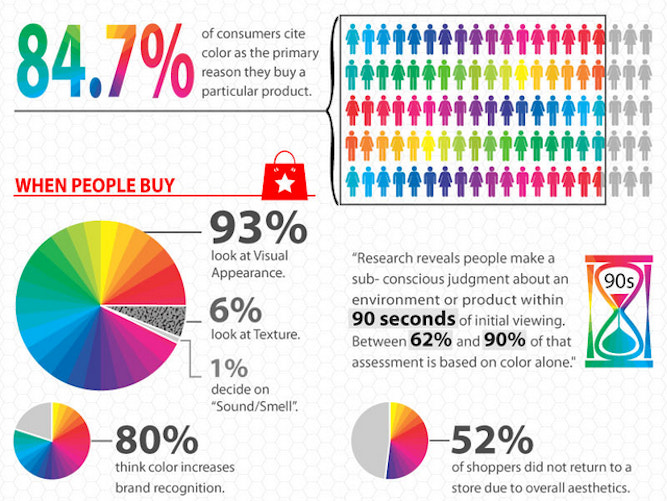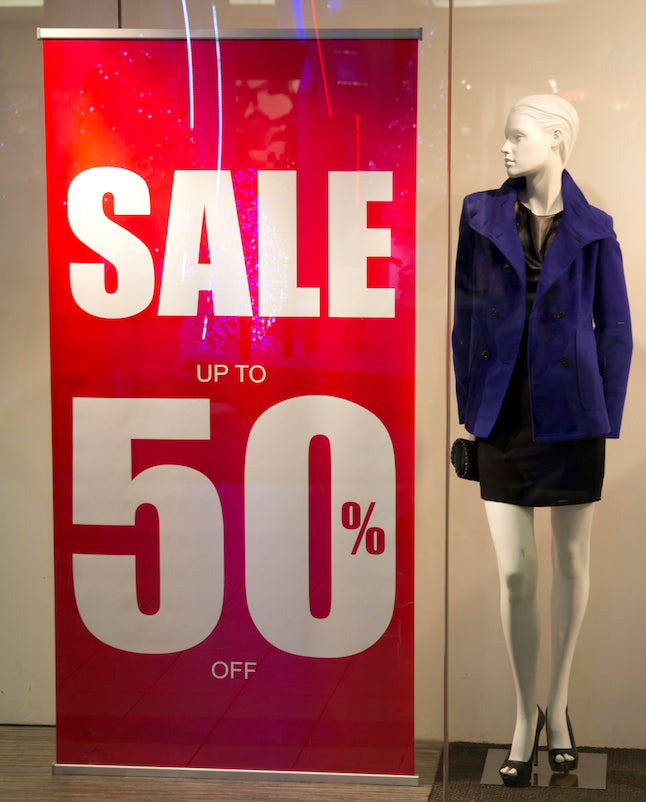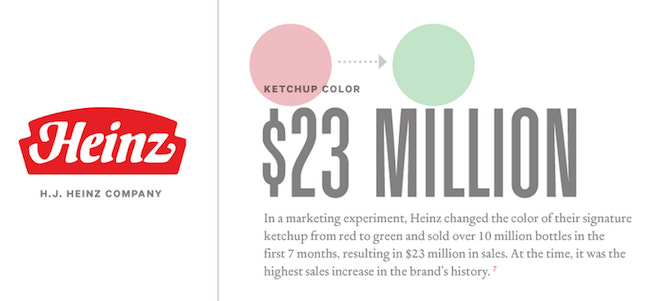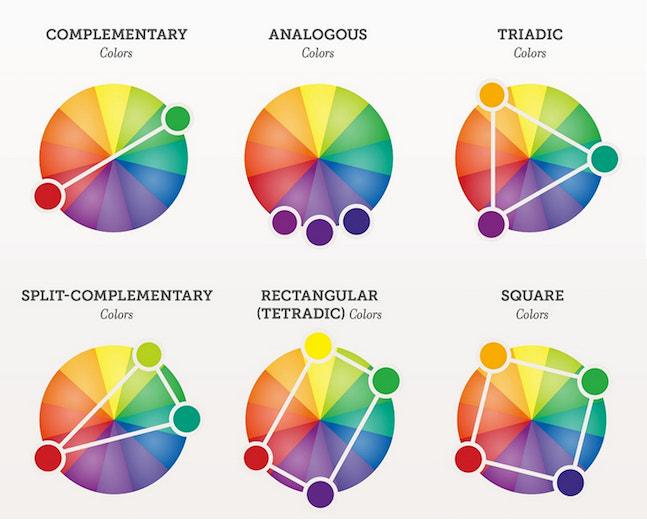我们都见过商店的橱窗sale signs promising amazing deals and price reductions. But have you ever noticed that most of those sale signs are red?
The reason is simple: Certain colors sell more merchandise. The color scheme you choose for your retail store, ecommerce site, andlogoimpacts your sales and influences whether customers are enticed to make a purchase.
There's a specificconsumer psychologyof color: The way humans react to color in our environment is a science that's been rigorously tested and studied for hundreds of years. So, let's start using some of the findings to your advantage.
Because color plays an important role in the human psyche, merchants can take some of the basic science and use it to improve sales. So, whether yourretail storeorvisual merchandising displaysneed a new paint job, or whether you're deciding on the theme for your next seasonalwindow display, here's how color can impact consumer purchase decisions — and how you can stack the deck in your favor.
Why Color Matters
If you're still on the fence about whether choosing the right color will actually impact your sales, here are a few things to consider: When a prospective customer first walks into your retail store, they make a subconscious judgment about your brand and product within 90 seconds. Guess how much of the first impression is based on color alone? Roughly 62% to 90%, according to researchers.
To complicate matters further, 52% of shoppers don't return to a store if they don't like the aesthetics. If that alone doesn't make you pay more attention to color, then consider this:93% of purchasing decisions are based on visual appearanceand 85% of consumers cite color as the primary reason for why they purchase a product.

Image:Pinterest
Another key area where color plays a big difference for retailers issignage. For example, colorplays a significant rolein how often ads are read, coming in at about 42% more than black-and-white ads, while boosting comprehension, learning, and reading significantly as well.
So, whether it's your "hours of operations" store sign, "we're open/closed" sign, or a big sale sign, be sure to add a touch of color if you want them noticed.

Image:Pinterest
The Influence of Color
It might be hard to imagine that color could influence spending habits to such a degree, but it's a critical variable that influences us on both a conscious and subconscious level.
For example, It's fine and dandy to hear that the color blue emotes feelings for trust and dependability since we even have the term "true blue" in our vocabulary. We also see blue regularly used in the logos for financial institutions. But, according to a study published in the Journal of Business Research,customers are actually 15% more likelyto return to stores with blue color schemes than to those with orange color schemes, which makes a lot of those intuitive insights true and credible.
Another example has to do with the color pink, which is thought to have calming effects. According toresearchpublished in the Journal of Orthomolecular Psychiatry, scientists discovered that when a person sees pink, it slows people's endocrine systems and relaxes tense muscles.
In other words, pink is associated with the idea of "relief." Now, isn't there a company that sells a pink syrup that's meant to relieve a number of pain-inducing symptoms? Oh right: Pepto Bismol.
 Sounds crazy, right? But that's just the beauty of color and its effects on the human psyche.
Sounds crazy, right? But that's just the beauty of color and its effects on the human psyche.
Or consider why all sale signs or clearance signs are red. According toa study published in the journal Emotion, professor Andrew Elliot found that people react faster and more forcefully when they see the color red. The primary reason behind the phenomena is that the color red enhances physical reactions — it's programmed into our psyche as a cue for danger. Retailers use this information to grab a customer's attention with red signs and cue them to take action by making a purchase.

Another interesting case study occurred when during a marketing experiment, Heinz changed the color of its classic ketchup fromred to green,一个颜色known to evoke emotions relating to health, tranquility, and wealth. The result? Over $23 million in sales in just the first month, amounting to the highest sales increase in the company's history at the time.

How Consumers Relate to Color
Now that you know why color matters, the next thing you're probably wondering is how to get it to work for you. When it comes to picking the perfect color scheme, the first question you'll have to ask yourself is "who is your brand's target market?" Are you targeting children, teenagers, young adults, adults, or seniors? Based on your customer demographics, behavioral data, and yourbuyer personas, your choice of color could vary dramatically.
简单地说,你的配色方案可以选择huge impact on the type of shoppers you attract, with certain color schemes being preferable for one type of retail store over another.
Here's a look at what I mean:

There's also a slight gender difference when it comes to color preferences as depicted in the graphic below, which can come in handy, especially when your retail store is specifically targeting one gender over the other.

Choosing a Color Scheme
Alright, now let's get into the nitty-gritty of actually picking a color scheme. There are several ways to approach this, as any designer or artist would attest, but here are the most common ways to pick a scheme.
You can pick a color scheme that is:
- Monochromatic Colors: These colors consist of varying tones of the same color.
- Complementary Colors:These colors are directly opposite each other on the color wheel.
- Analogous Colors:These are colors that lie on either side of any given color on a color wheel.
- Triadic Colors:This color scheme includes colors situated at 120 degrees from each other on the color wheel.
- Split-Complementary Colors:This color scheme uses a base color and two colors adjacent to the complementary color
- Rectangular Colors:This color scheme uses four colors arranged into two complementary pairs
- Square Colors:This color scheme uses four colors spaced evenly around the color wheel
消费者个人颜色反应
Lastly, take a look at this infographic from Marketo to highlight how consumers react to individual colors. This is particularly helpful when you're just starting out and picking your logo colors. Or use this to guide you when picking the primary and accent colors for your retail store.
![Why color matters for brands | Shopify Retail]() How Did You Pick Your Colors?
How Did You Pick Your Colors?
That's a lot to digest when it comes to using the science of colors in a retail setting. However, I'd love to hear about how you went about picking the colors for your brand, products, and most importantly yourretail store. Or, share with us what study, insight, statistic, or graphic stood out most to you from this post and how it changed your outlook when it comes to the influence color has on consumer habits.



 How Did You Pick Your Colors?
How Did You Pick Your Colors?